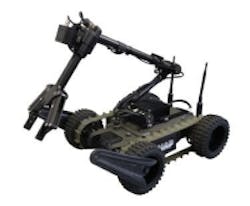Reconnaissance robots use infrared cameras for military threat detection
Designed for military reconnaissance teams to detect threats, including those at locations not accessible to humans, the FENIX from PIAP is a light robot that uses infrared cameras for threat detection that can be transported in a backpack.
Measuring just 23.62 x 19.68 x 7.4 in., FENIX can observe, lift, and neutralize dangerous loads or transport sabotage equipment. It features an imaging system based on a Xenics XTM-640 thermal imaging camera core. The XTM-640 is a 640 x 480 uncooled microbolometer (a-Si) infrared detector with a spectral band of 8 to 14 µm and a pixel pitch of 17 µm. The imager can achieve speeds of 50 Hz, and features analog output, as well as GigE and Camera Link. In addition to the imager, the imaging system features a 100 mm LWIR lens.
Also contained in the vision system is a visual camera, which along with the infrared camera, are mounted on a pan-tilt unit on the manipulator arm of the robot. The robot is controlled via radio or optical fiber, and a video signal can be displayed or recorded on the handheld control panel. FENIX’s control panel provides access to camera position and parameters, allowing users to adapt the robot to its surroundings.
FENIX itself is a 33 lb. robot without manipulator, or 40 lb. robot with manipulator, with a modular structure that allows for easy installation or replacement of additional equipment. Its chassis is equipped with tracks and wheels with moveable front flippers, which ensures that the vehicle can operate on hardened roads, dirt roads, tracks, and pathless areas in any environment with inclines up to 45°. Furthermore, the hybrid track-wheel mechanism enables users to remove the wheels and front flippers to reduce height and width of the robot, making hard-to-reach areas more accessible.
PIAP’s robot also features a handle for explosives trace detector (MO-2M), an open field range of more than 1640 ft, and top speeds of more than 6 mph.
View more information on the FENIX.
View more information on the Xenics XTM-640.
Share your vision-related news by contacting James Carroll, Senior Web Editor, Vision Systems Design
To receive news like this in your inbox, click here.
Join our LinkedIn group | Like us on Facebook | Follow us on Twitter
About the Author

James Carroll
Former VSD Editor James Carroll joined the team 2013. Carroll covered machine vision and imaging from numerous angles, including application stories, industry news, market updates, and new products. In addition to writing and editing articles, Carroll managed the Innovators Awards program and webcasts.
